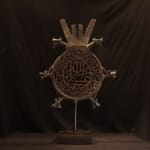Deccan Calligraphic 'Alam Finial, Seventeenth to Eighteenth Century AD
Bronze
57.5 x 47.4 x 5.5 cm
22 5/8 x 18 5/8 x 2 1/8 in
22 5/8 x 18 5/8 x 2 1/8 in
LI.3258
Further images
-
(View a larger image of thumbnail 1
)

-
(View a larger image of thumbnail 2
)

-
(View a larger image of thumbnail 3
)

-
(View a larger image of thumbnail 4
)

-
(View a larger image of thumbnail 5
)

-
(View a larger image of thumbnail 6
)

-
(View a larger image of thumbnail 7
)

-
(View a larger image of thumbnail 8
)

This brilliantly ornate seventeenth to eighteenth-century 'Alam is a testimony to the artistic refinement the Mughal dynasty. The finial is composed of an outer circular band flanked by dragon-like makara...
This brilliantly ornate seventeenth to eighteenth-century 'Alam is a testimony to the artistic refinement the Mughal dynasty. The finial is composed of an outer circular band flanked by dragon-like makara heads, with an inner band decorated with openwork calligraphic interlace surrounding a teardrop form in its centre with calligraphy "Muhammad and his worshippers".
A Makara is a legendary sea-creature in Indian mythology, often appearing in Mughal artefacts as an ornament. This beautiful artefact crafted under the Mughal Dynasty reflects the religious splendour and refinement characteristic of this period.
The Mughal Empire was one of the most powerful and influential empires within the South Asian subcontinent, stretching from the edge of the Indus river basin to Bangladesh in the East. The Islamic empire reigned from the 16th to the 19th century, led by notable rulers such as Akbar, Aurangzeb, and Shah Jahan. The Mughals contributed greatly to the regional architectural styles of South Asia, establishing national monuments in present-day India, Pakistan, Bangladesh, and Afghanistan.
The Mughal dynasty was founded in 1526 when Babur, a Central Asian Muslim prince, followed the example of his ancestor Timur (d.1405) and invaded the land he knew as Hindustan (the Indian subcontinent). Babur's languages were Turki, in which he wrote his memoirs, and Persian, the language of culture across Iran and Central Asia. The "golden age" of Mughal art covered the period from about 1580 to 1650. Hindu and Muslim artists and craftsmen from the northern regions of the Indian subcontinent worked with Iranian masters in the royal workshops. Combining their different traditions and the technological and cultural transfer between various artisans resulted in a new distinctive style, including elements of all these different cultures.
A Makara is a legendary sea-creature in Indian mythology, often appearing in Mughal artefacts as an ornament. This beautiful artefact crafted under the Mughal Dynasty reflects the religious splendour and refinement characteristic of this period.
The Mughal Empire was one of the most powerful and influential empires within the South Asian subcontinent, stretching from the edge of the Indus river basin to Bangladesh in the East. The Islamic empire reigned from the 16th to the 19th century, led by notable rulers such as Akbar, Aurangzeb, and Shah Jahan. The Mughals contributed greatly to the regional architectural styles of South Asia, establishing national monuments in present-day India, Pakistan, Bangladesh, and Afghanistan.
The Mughal dynasty was founded in 1526 when Babur, a Central Asian Muslim prince, followed the example of his ancestor Timur (d.1405) and invaded the land he knew as Hindustan (the Indian subcontinent). Babur's languages were Turki, in which he wrote his memoirs, and Persian, the language of culture across Iran and Central Asia. The "golden age" of Mughal art covered the period from about 1580 to 1650. Hindu and Muslim artists and craftsmen from the northern regions of the Indian subcontinent worked with Iranian masters in the royal workshops. Combining their different traditions and the technological and cultural transfer between various artisans resulted in a new distinctive style, including elements of all these different cultures.







